The second article related to 3D printing technology in Nature for 2025 was published on April 23. Researchers from Princeton University published an article titled “Modular chiral origami metamaterials”. The core content of this research is the development of a modular chiral origami metamaterial with multimodal deformation mechanisms using 3D printing technology, which shows tremendous application potential in mechanics, thermodynamics, optics, and other fields, achieving groundbreaking progress.This research’s first author isTuo Zhao, who studied at Dalian University of Technology for his undergraduate degree and is currently a postdoctoral researcher at Princeton University.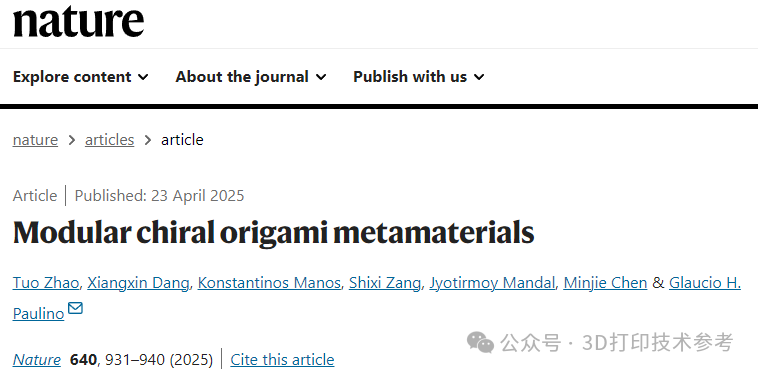

Mechanical metamaterials are artificial materials designed with special structures that can exhibit extraordinary properties beyond those of ordinary materials, much like “Transformers”. Traditional designs use rigidly connected octahedral trusses, Kelvin lattices, and other unit structures, which are valuable in lightweight characteristics, impact resistance, and fracture research. However, these structures have relatively simple deformation modes, akin to LEGO blocks that can only be assembled in a straight line.
The upgraded origami metamaterials borrow from the principles of origami and paper cutting, using flexible hinges for connections, allowing the material to achieve free deformation in three-dimensional space, similar to foldable origami works. This design not only breaks the limitations of traditional linear deformation but also achieves a coupling effect of twisting and stretching through chiral structures.However, the multi-degree-of-freedom deformation introduced by geometric nonlinearity still requires integrated control or external excitation to drive it. Additionally, existing research often focuses on limited physical properties under uniaxial loading.
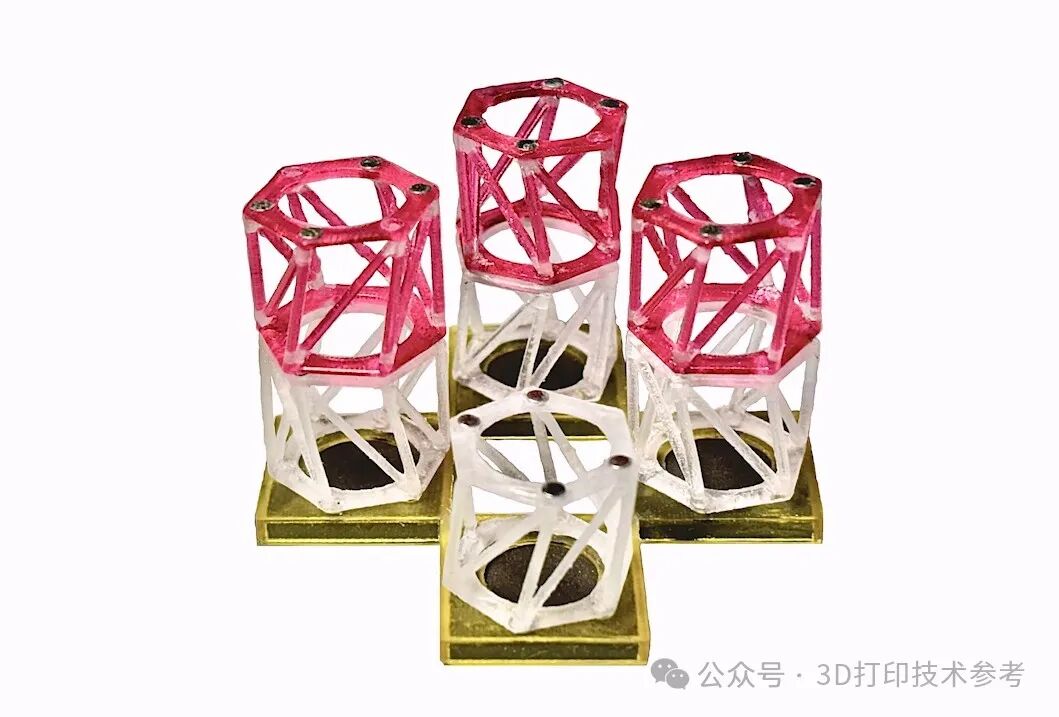

The latest metamaterials developed by Tuo Zhao and others can achieve combined motion of translation and twisting with a single control, and can freely expand and contract in three directions.
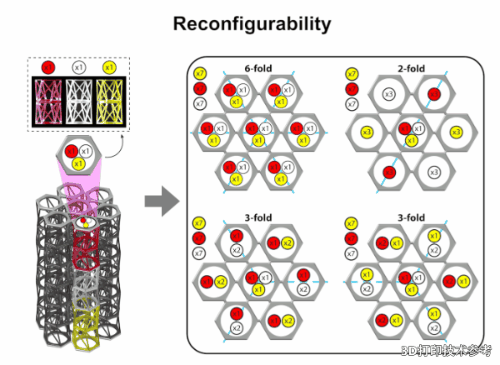
The design inspiration for this material comes from origami art, integrating two special structures: chiral helical arrays (which determine the twisting direction like a DNA double helix) and stretchable tessellated structures (which become thicker when stretched like a honeycomb). Its innovation lies in the modular assembly method, allowing components to be freely replaced like LEGO blocks: it can adjust to achieve near-zero/negative Poisson’s ratio and other special properties, as well as preset multiple stable states. By optimizing the module shapes, chiral features, and material properties, it is akin to programming the material, allowing precise control over the mechanical response of the structure, such as setting different energy barriers.
This “programmable metamaterial” has enormous application potential, capable of creating seismic buffer devices; after cross-disciplinary integration of magnetic/thermal/optical functions, it can produce robots that can deform and move, as well as develop smart temperature-controlled buildings. The entire design breaks the limitations of traditional materials’ single functionality, making it possible for a single control to achieve multimodal motion, truly realizing a deep integration of materials and intelligent systems.
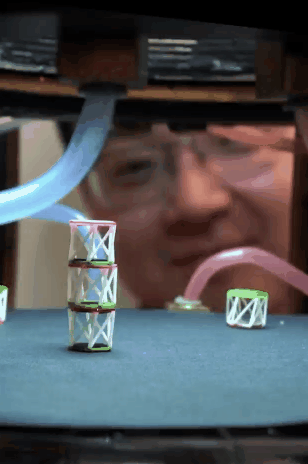

3D printing technology references note that this modular chiral origami metamaterial consists of unit cells, hinge-connected tessellated structures, and assembly plates. These structures are all manufactured using PolyJet 3D printing technology. The most significant feature of this technology is its high precision and ability to integrate multiple materials, meeting the complex geometric shapes and different mechanical performance requirements of metamaterials.
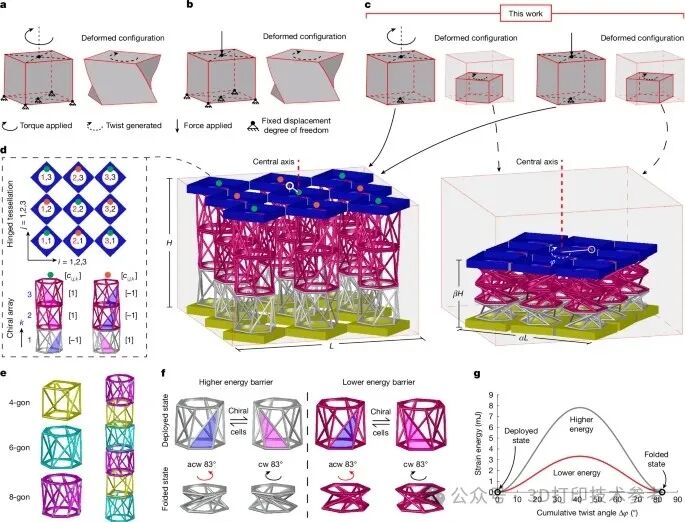
Multimodal metamaterials composed of hinge-connected and chiral origami-inspired lattice units
The unit cells consist of rods and soft joints. During the manufacturing process, the rods used four materials with similar elastic moduli, approximately 2.2 GPa; the soft joints mixed multiple materials during printing, achieving elastic moduli of 1.7 MPa, 2.7 MPa, and 3.9 MPa depending on the material combinations. This multi-material 3D printing approach allows different parts of the metamaterial to possess different mechanical properties, thus achieving the desired multimodal deformation behavior.
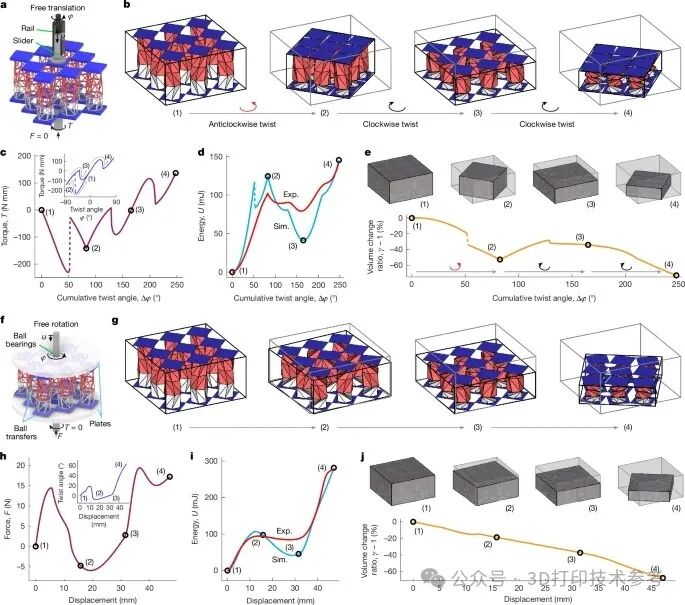
3D printing technology can accurately construct various complex geometric structures of modular chiral origami metamaterials. Taking the hexagonal unit cell as an example, its unfolded height is 28.3 mm, folded height is 12.6 mm, and polygon radius is 16.8 mm. These precise dimensional parameters are crucial for ensuring the stability and repeatability of the unit cells during the deformation process. Furthermore, 3D printing can also achieve the transition from shell-based origami to rod-based lattice units, providing greater flexibility for the geometric design of metamaterials. Through 3D printing, researchers can easily combine various regular polygons as the top and bottom faces of the unit cells, creating metamaterial modules with different geometric characteristics and deformation performances, such as quadrilateral, hexagonal, and octagonal unit cells.
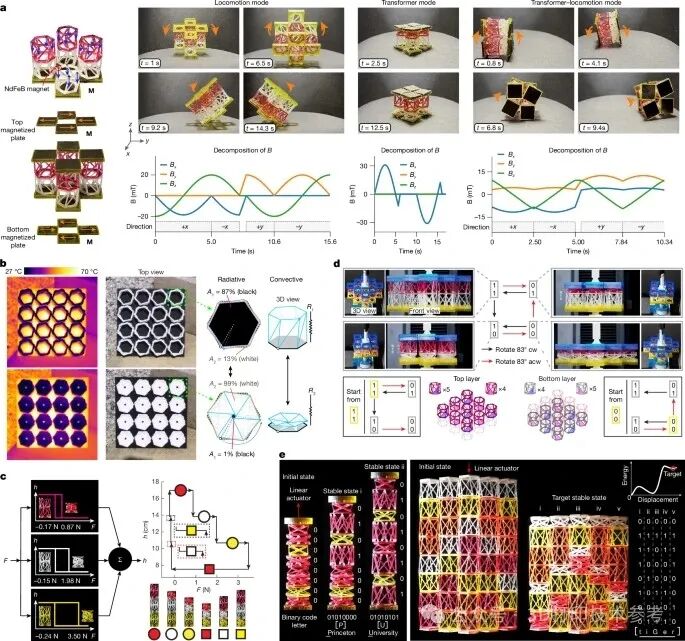
The manufacturing process of modular chiral origami metamaterials is highly modular. Each unit cell can be individually 3D printed and tested, and then assembled as needed to form larger-scale metamaterial structures. This modular assembly method not only improves manufacturing efficiency but also facilitates the optimization and adjustment of the metamaterial’s performance. Researchers can quickly manufacture metamaterial modules with different mechanical responses by changing the geometric shapes of the unit cells, chiral assignments, and material combinations, and evaluate their performance through experimental and simulation analysis, thus achieving precise control over the overall performance of the metamaterials. At the same time, modular assembly also makes the maintenance and replacement of metamaterials more convenient, as only the problematic modules need to be replaced without the need to remanufacture the entire structure.
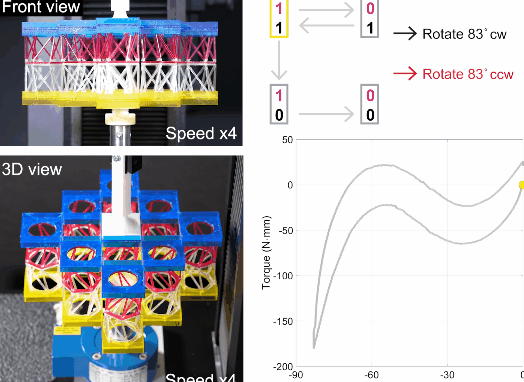
 In summary, 3D printing technology plays a key role in the manufacturing process of this metamaterial, enabling the precise construction of complex geometric structures while integrating multiple materials into a single 3D print, which is crucial for creating metamaterials with integrated mechanical properties. The metamaterials in this study are based on highly modular assembly, allowing for the reprogramming of instability and local chirality control, with adjustable load-bearing capacity and scalability. This provides a pathway for multimodal, multi-stability, and reprogrammable machines, applicable to robotic transformers, thermal regulation, mechanical memory in hysteresis loops, non-exchange state transitions, and plug-and-play functional components for energy absorption and information encryption. Source: 3D Printing Technology Reference 【Technical Progress】
In summary, 3D printing technology plays a key role in the manufacturing process of this metamaterial, enabling the precise construction of complex geometric structures while integrating multiple materials into a single 3D print, which is crucial for creating metamaterials with integrated mechanical properties. The metamaterials in this study are based on highly modular assembly, allowing for the reprogramming of instability and local chirality control, with adjustable load-bearing capacity and scalability. This provides a pathway for multimodal, multi-stability, and reprogrammable machines, applicable to robotic transformers, thermal regulation, mechanical memory in hysteresis loops, non-exchange state transitions, and plug-and-play functional components for energy absorption and information encryption. Source: 3D Printing Technology Reference 【Technical Progress】
【Technical Progress】 Breakthrough in overcoming the technical bottleneck of low performance in 3D printed thermoelectric materials! Surpassing the highest levels of traditional bulk materials!
【Technical Progress】 Scientists have 3D printed functional human brain tissue for the first time
【Technical Progress】 Science publishes significant breakthroughs in the field of 3D printing: magnetic fields significantly reduce pore defects


